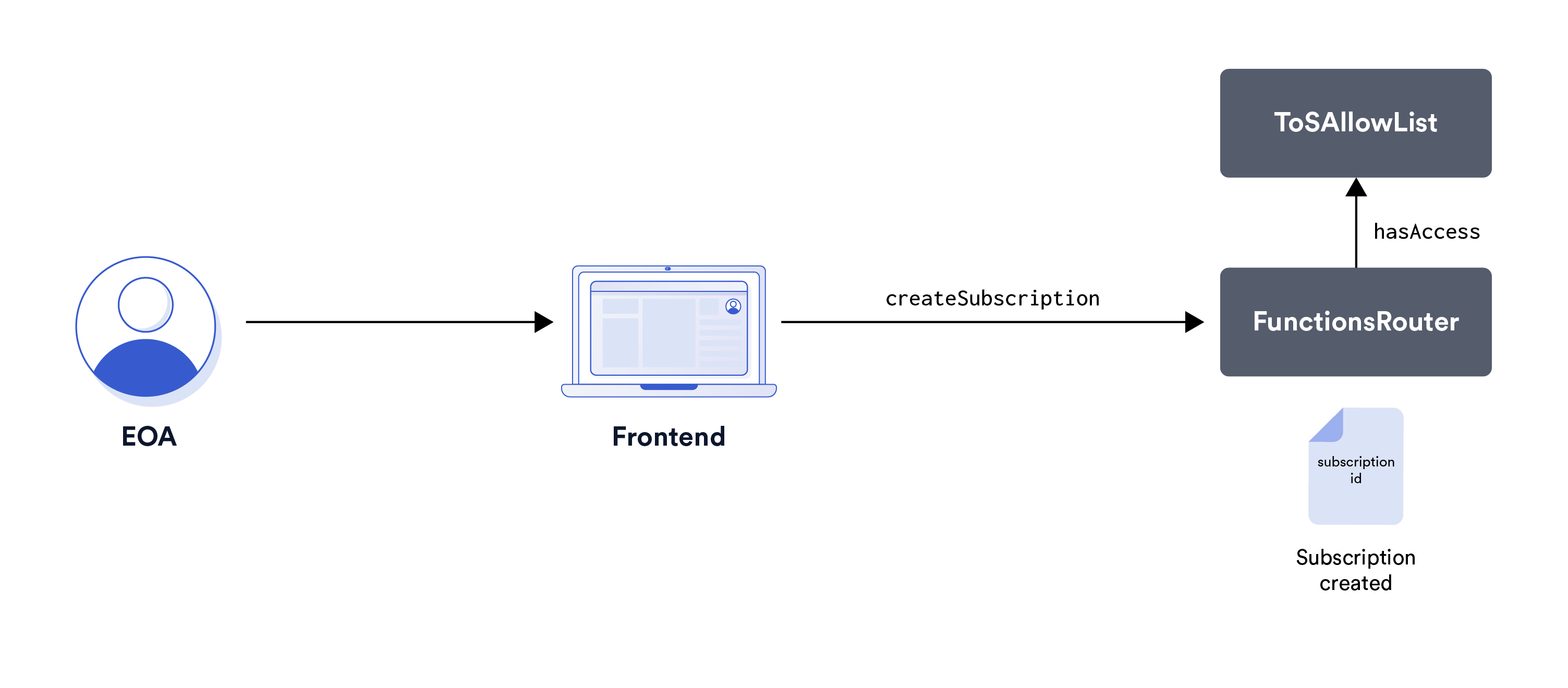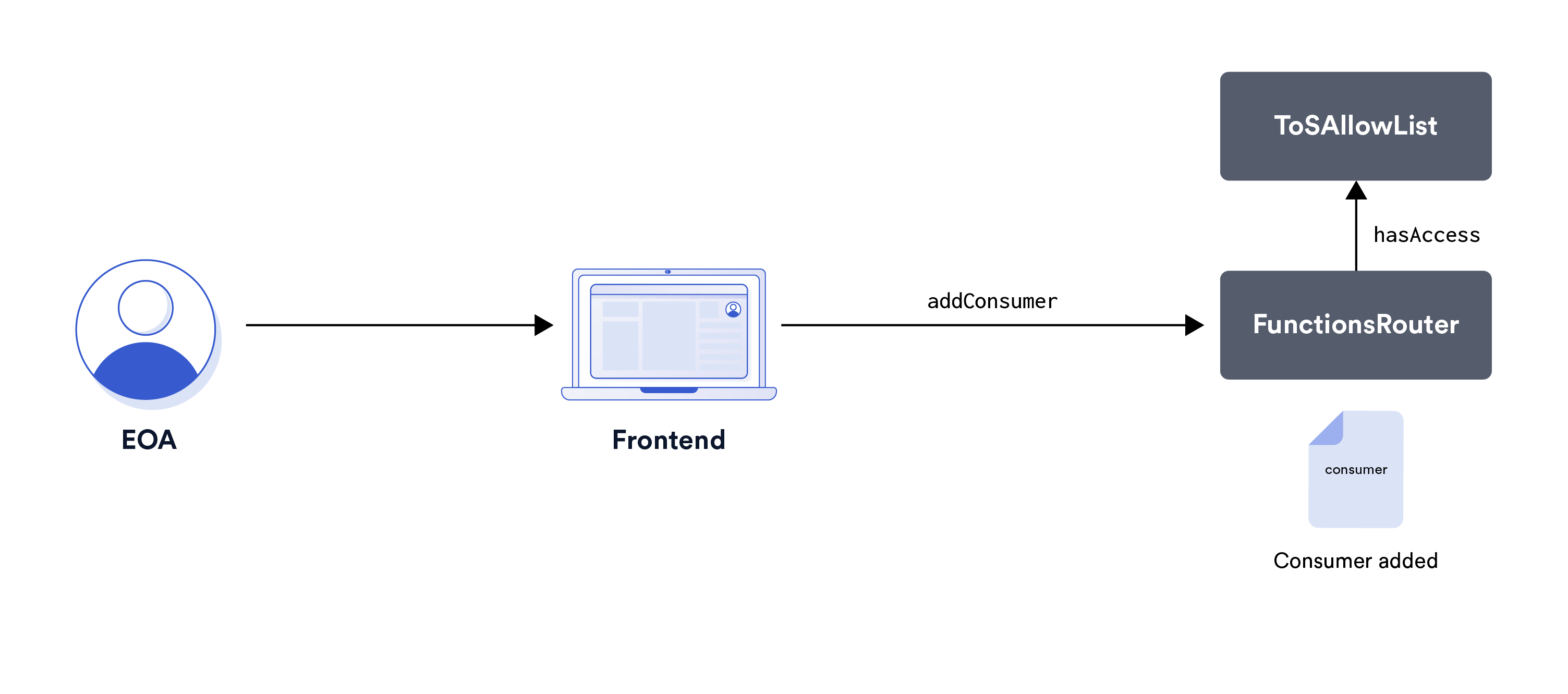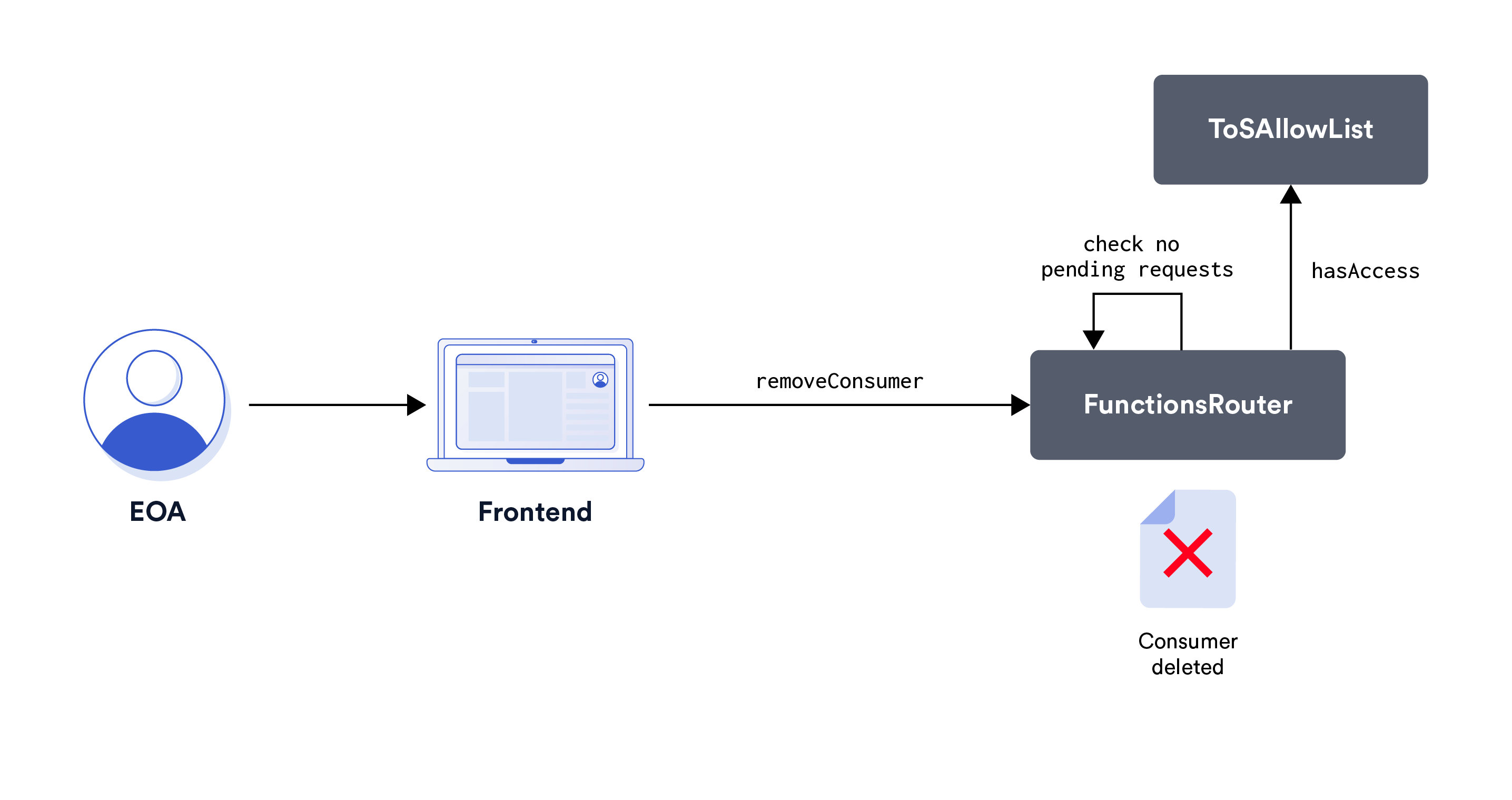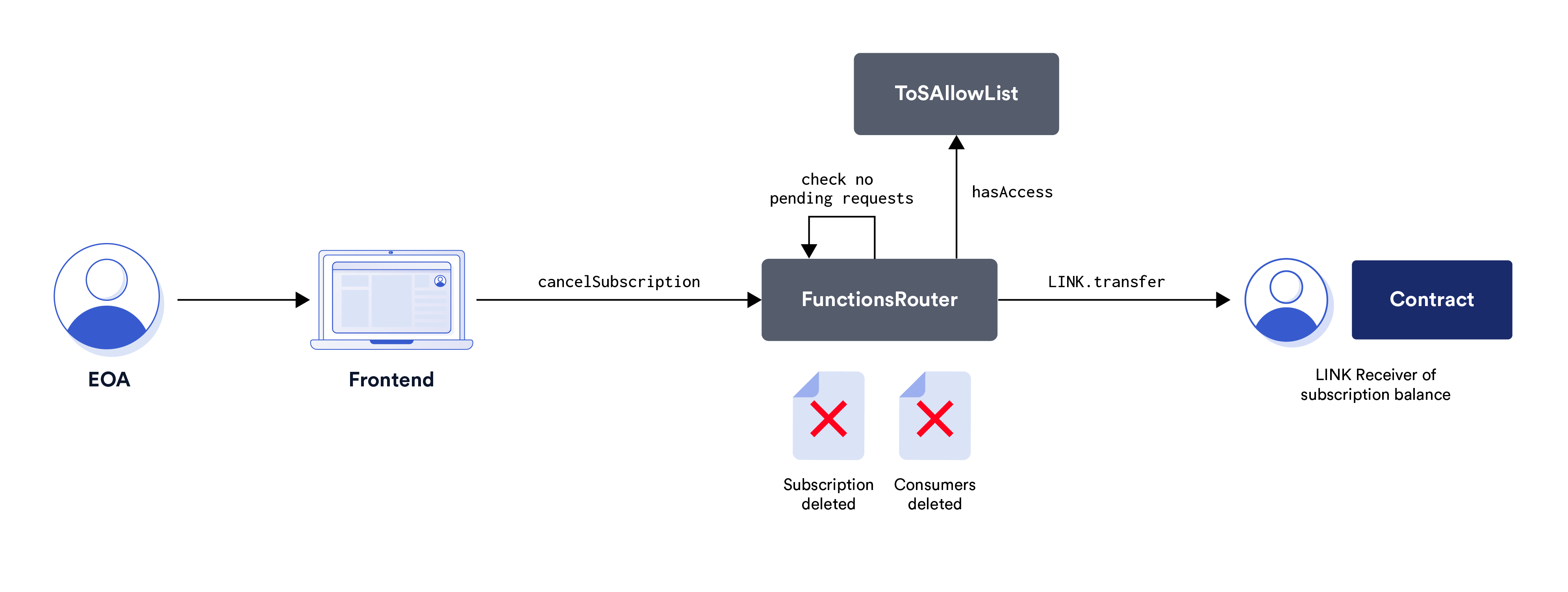Chainlink Functions Architecture
Request and Receive Data
This model is similar to the Basic Request Model: The consumer contract initiates the cycle by sending a request to the FunctionsRouter contract. Oracle nodes watch for events emitted by the FunctionsCoordinator contract and run the computation off-chain. Finally, oracle nodes use the Chainlink OCR protocol to aggregate all the returned before passing the single aggregated response back to the consumer contract via a callback function.

The main actors and components are:
- Initiator (or end-user): initiates the request to Chainlink Functions. It can be an EOA (Externally Owned Account) or Chainlink Automation.
- Consumer contract: smart contract deployed by developers, which purpose is to interact with the FunctionsRouter to initiate a request.
- FunctionsRouter contract: manages subscriptions and is the entry point for consumers. The interface of the router is stable. Consumers call the
sendRequestmethod to initiate a request. - FunctionsCoordinator contracts: interface for the Decentralized Oracle Network. Oracle nodes listen to events emitted by the coordinator contract and interact with the coordinator to transmit the responses.
- DON: Chainlink Functions are powered by a Decentralized Oracle Network. The oracle nodes are independent of each other and are responsible for executing the request's source code. The nodes use the Chainlink OCR protocol to aggregate all the nodes' responses. Finally, a DON's oracle sends the aggregate response to the consumer contract in a callback.
- Secrets endpoint: To transmit their secrets, users can encrypt them with the DON public key and then upload them to the secrets endpoint, a highly available service for securely sharing encrypted secrets with the nodes. Note: An alternative method involves self-hosting secrets. In this approach, users provide a publicly accessible HTTP(s) URL, allowing nodes to retrieve the encrypted secrets. Refer to the secrets management page for detailed information on both methods.
- Serverless Environment: Every Oracle node accesses a distinct, sandboxed environment for computation. While the diagram illustrates an API request, the computation isn't restricted solely to this. You can perform any computation, from API calls to mathematical operations, using vanilla Deno code without module imports. Note: All nodes execute identical computations. If the target API has throttling limits, know that multiple simultaneous calls will occur since each DON node will independently run the request's source code.
Let's walk through the sequence of interactions among these components, as illustrated in the diagram:
- If there are secrets, a user encrypts secrets with the public key linked to the DON master secret key (MSK) and then uploads the encrypted secrets to the secrets endpoint. The secrets endpoint pushes the encrypted secrets to the nodes part of the DON (The secrets capability depicted in this diagram is called threshold encryption and is explained in secrets management).
- An EOA (Externally Owned Account) or Chainlink Automation initiates the request by calling the consumer contract.
- The consumer contract should inherit the FunctionsClient contract. This ensures it will be able to receive responses from the FunctionsRouter contract via the
handleOracleFulfillmentcallback. The router contract starts the billing to estimate the fulfillment costs and block the amount in the reservation balance (To learn more, read Cost simulation). Then it calls the FunctionsCoordinator contract. - The coordinator contract emits an
OracleRequestevent containing information about the request. - On reception of the event by the DON, the DON's nodes decrypt the secrets using threshold decryption (The threshold encryption feature is explained in secrets management). Each DON's Oracle node executes the request's source code in a serverless environment.
- The DON runs the Off-chain Reporting protocol(OCR) to aggregate the values returned by each node's execution of the source code.
- A DON's oracle node transmits the attested report (which includes the aggregated response) to the FunctionsCoordinator contract.
- The FunctionsCoordinator contract calls the FunctionsRouter's
fulfillmethod to calculate the fulfillment costs and finalize the billing (To learn more, read Cost calculation). - The FunctionsRouter contract calls the consumer contract's callback with the aggregated response.
Note: Chainlink Functions requests are not limited to API requests. The diagram depicts an example of API requests, but you can request the DON to run any computation.
Subscription Management
Chainlink Functions do not require your consumer contracts to hold LINK tokens and send them to oracles when making requests. Instead, you must create a subscription account and fund it to pay for your Chainlink Functions requests, so your consumer contracts don't need to hold LINK when calling Chainlink Functions.
Concepts
- Terms of service (ToS): Before interacting with Chainlink Functions, users must agree to the terms of service. Once signed, the accounts that can manage subscriptions are added to the
allowedSendersin the ToS allow list contract. - Chainlink Functions Subscription Manager: A user interface that allows users to agree to the sign Terms of service and interact with the FunctionsRouter to manage subscriptions.
- Subscription account: An account that holds LINK tokens and makes them available to fund requests to Chainlink DON. A Subscription ID uniquely identifies each account.
- Subscription ID: 64-bit unsigned integer representing the unique identifier of the Subscription account.
- Subscription owner: The wallet address that creates and manages a Subscription account. Any account can add LINK tokens to the subscription balance. Still, only the owner can add consumer contracts to the subscription, remove consumer contracts from the subscription, withdraw funds, or transfer a subscription. Only the subscription owner can generate encrypted secrets for requests that use their Subscription ID.
- Subscription balance: The amount of LINK maintained on your Subscription account. Requests from consumer contracts are funded as long as sufficient funds are in the balance, so be sure to maintain sufficient funds in your Subscription balance to pay for the requests and keep your applications running.
- Subscription reservation: The amount of LINK blocked on the Subscription balance. It corresponds to the total LINK amount to be paid by in-flight requests.
- Effective balance: The amount of LINK available on your Subscription account.
Effective balance = Subscription balance - Subscription reservation. - Subscription consumers: Consumer contracts are approved to use funding from your Subscription account while making Chainlink Functions requests. The consumers receive response data in a callback.
Accept ToS
To ensure compliance and governance, Chainlink Functions mandates that any account that manages a subscription must first accept the platform's Terms of Service (ToS). The acceptance is verified by cross-referencing the account with the allowedSenders registry contained within the TermsOfServiceAllowList contract.

The acceptance process is initiated via the Chainlink Functions Subscription Manager. After a user accepts the ToS by generating the required signature with their externally owned account (EOA), they transmit proof of acceptance to the TermsOfServiceAllowList contract. Upon successful validation of the proof, the EOA is added to the allowedSenders registry, permitting it to manage subscriptions.
Create Subscription

After the ToS is accepted, EOAs can create subscriptions. Upon creation, the FunctionsRouter assigns a unique identifier, Subscription ID.
Note: EOAs can directly interact with the FunctionsRouter contract using their preferred web3 library, such as web3.js or ethers.js.
Fund Subscription

You must fund your subscription accounts with enough LINK tokens:
- Connect your EOA to the Chainlink Functions Subscription Manager.
- Fund your subscription account. The Chainlink Functions Subscription Manager abstracts the following:
- Call
transferAndCallon the LINK token contract, transferring LINK tokens along with the Subscription ID in the payload. - The FunctionsRouter contract implements
onTokenTransfer: It parses the Subscription ID from the payload and funds the subscription account with the transferred LINK amount.
- Call
Note: EOAs can directly interact with the LinkToken contract using their preferred web3 library, such as web3.js or ethers.js.
Add Consumer

You must allowlist your consumers' contracts on your subscription account before they can make Chainlink Functions requests:
- Connect your EOA to the Chainlink Functions Subscription Manager.
- Add the address of the consumer contract to the subscription account.
- The Chainlink Functions Subscription Manager interacts with the FunctionsRouter contract to register the consumer contract address to the subscription account.
Note: EOAs can directly interact with the FunctionsRouter contract using a web3 library, such as web3.js or ethers.js.
Remove Consumer

To prevent further Chainlink Functions requests from a given consumer contract, you must remove it from your subscription account:
- Connect your EOA to the Chainlink Functions Subscription Manager.
- Remove the address of the consumer contract from the subscription account.
- The Chainlink Functions Subscription Manager communicates with the FunctionsRouter contract to remove the consumer contract address from the subscription account.
Note: You can still remove consumers from your subscription even if in-flight requests exist. The consumer contract will still receive a callback, and your Subscription Account will be charged.
Note: EOAs can directly interact with the FunctionsRouter contract using a web3 library, such as web3.js or ethers.js.
Cancel Subscription

To cancel a subscription:
- Connect your EOA to the Chainlink Functions Subscription Manager.
- Cancel your subscription, providing the Subscription Balance receiver account address. The Chainlink Functions Subscription Manager handles the following processes:
- Invokes the
cancelSubscriptionfunction on the FunctionsRouter contract, deleting the Subscription ID and removing all associated consumers. - Transfers the remaining Subscription Balance to the specified receiver account.
- Invokes the
Note: EOAs can directly interact with the FunctionsRouter contract using their preferred web3 library, such as web3.js or ethers.js.
Note: Subscriptions cannot be canceled while there are in-flight requests. Furthermore, any expired requests (requests that have yet to receive a response within 5 minutes) must be timed out before cancellation.
Transferring ownership of a Subscription
Transferring ownership is currently only supported using the Functions Hardhat Starter kit or the Functions Toolkit NPM package:
- Use the
functions-sub-transfercommand to initiate the transfer of ownership by specifying the new owner's address. - As a prerequisite, the prospective owner must be part of the
allowedSendersregistry within the TermsOfServiceAllowList contract. This verifies their acceptance of the Chainlink Functions' Terms of Service (ToS). - The prospective owner should use the Functions Hardhat Starter kit and run the
functions-sub-acceptcommand to confirm the ownership transfer.
Note: This guide will be updated as soon as the Chainlink Functions Subscription Manager supports ownership transfers.
